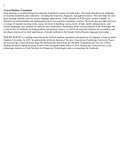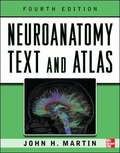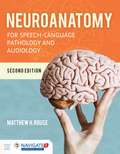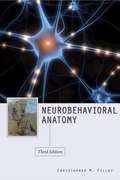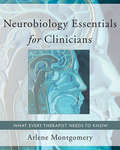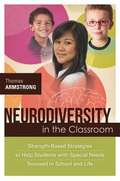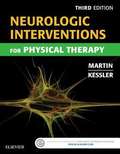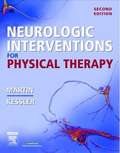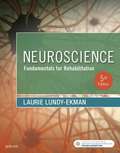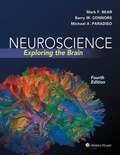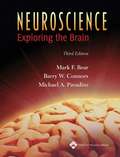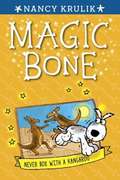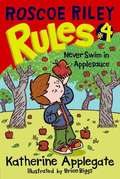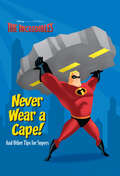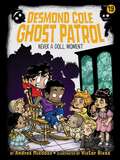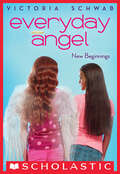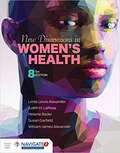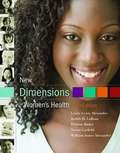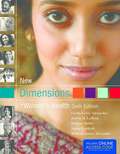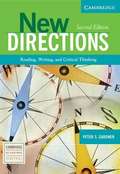- Table View
- List View
Neural Machine Translation
by Philipp KoehnDeep learning is revolutionizing how machine translation systems are built today. This book introduces the challenge of machine translation and evaluation - including historical, linguistic, and applied context -- then develops the core deep learning methods used for natural language applications. Code examples in Python give readers a hands-on blueprint for understanding and implementing their own machine translation systems. <p><p>The book also provides extensive coverage of machine learning tricks, issues involved in handling various forms of data, model enhancements, and current challenges and methods for analysis and visualization. <p><p>Summaries of the current research in the field make this a state-of-the-art textbook for undergraduate and graduate classes, as well as an essential reference for researchers and developers interested in other applications of neural methods in the broader field of human language processing.
Neuroanatomy Text and Atlas (4th Edition)
by John H. MartinA regional and functional approach to learning human neuroanatomy <p><p> A Doody's Core Title for 2015!<p> Neuroanatomy:Text and Atlas covers neuroanatomy from both a functional and regional perspective to provide an understanding of how the components of the central nervous system work together to sense the world around us, regulate body systems, and produce behavior. This trusted text thoroughly covers the sensory, motor, and integrative skills of the brains and presents an overview of the function in relation to structure and the locations of the major pathways and neuronal integrative regions. <p> Neuroanatomy:Text and Atlas also teaches you how to interpret the new wealth of human brain images by developing an understanding of the anatomical localization of brain function. The authoritative core content of myelin-stained histological sections is enhanced by informative line illustrations, angiography, and brain views produced by MRI, and other imaging technologies. <p> NEW to this edition: <p> Revised and updated to reflect advances in clinical neuroanatomy and neural science<br> Full-color illustrations have been added to enrich the text<br> Chapters begin with a clinical case to illustrate the connections and functions of the key material<br> Chapters end with a series of multiple-choice review questions<br> <p>Features and Benefits: <p> Increases knowledge of the regional and functional organization of the spinal cord and brain, one system at a time<br> Provides thorough coverage of the sensory, motor, and integrative systems of the brain, together with cerebral vasculature<br> Promotes understanding of the complex details of neuroanatomy needed for accurate interpretation of radiological image<br> Comprehensive atlas provides key views of the surface anatomy of the central nervous systems and photographs of myelin-stained sections in three anatomical planes<br> Includes learning aids such as clinical topics, boxes, chapter summaries, and a Glossary of key terms and structures
Neuroanatomy: For Speech-Language Pathology and Audiology
by Matthew RouseThis student-friendly and engaging text is organized into four main sections: Part I introduces students to the nervous system; Part II discusses the main neurological structures; Part III focuses on the neurology of speech, language, hearing, cognition, emotion, and swallowing; and Part IV delves into practicing neuroanatomy in the field.
Neurobehavioral Anatomy, Third Edition
by Christopher M. FilleyThoroughly revised and updated to reflect key advances in behavioral neurology, Neurobehavioral Anatomy, Third Edition is a clinically based account of the neuroanatomy of human behavior centered on a consideration of behavioral dysfunction caused by disorders of the brain. A concise introduction to brain-behavior relationships that enhances patient care and assists medical students, the book also serves as a handy reference to researchers, neuroscientists, psychiatrists, and geriatricians. The book outlines how cognitive and emotional functions are represented and organized in the brain to produce the behaviors regarded as uniquely human. It reviews the effects of focal and diffuse brain lesions, and from this analysis a conception of the normal operations of the healthy brain emerges. Christopher M. Filley integrates data and material from different disciplines to create a concise and accessible synthesis that informs the clinical understanding of brain-behavior relationships. Clinically practical and theoretically stimulating, the book is an invaluable resource for those involved in the clinical care and study of people with neurobehavioral disorders. Including a useful glossary and extensive references guiding users to further research, the third edition will be of significance to medical students, residents, fellows, practicing physicians, and the general reader interested in neurology.
Neurobiology Essentials for Clinicians: What Every Therapist Needs to Know
by Arlene Montgomery Allan N. SchoreThis book presents an overview of the latest theories of affect regulation and focuses on how these theories work in clinical settings and how therapists can be taught to implement them. The notion of teaching and learning will be extended by the theories themselves-the author presents methods of education that enact the theories being taught. The book is divided into eight chapters, each one highlighting a particular structure or related structures of the brain. Suggestions for learning how to clinically apply the neurobiological/neuroanatomical information are offered. What is so unique about this book is that the bulk of the chapters are clinical dialogue, accompanied by neurobiological commentary. Thus, readers can see for themselves, during the course of parts of sessions, just how a "neurobiological outlook" can inform therapeutic understandings of what clients are doing and saying. The result is a very user-friendly learning experience for readers, as they are taken along a journey of understanding various brain systems and how they relate to psychotherapeutic principles. Elegantly bridging the gap between the academic and clinical domains, this book is essential for anyone interested in the application of neurobiological principles to psychotherapy and wishes to learn about neurobiology without feeling overwhelmed or intimidated.
Neurodiversity in the Classroom: Strength-Based Strategies to Help Students with Special Needs Succeed in School and Life
by Thomas ArmstrongA new concept on human diversity has emerged over the past 10 years that promises to revolutionize the way educators provide services to students with special needs: neurodiversity. Just as we celebrate diversity in nature and cultures, so too do we need to honor the diversity of brains among our students who learn, think, and behave differently. In Neurodiversity in the Classroom, best-selling author Thomas Armstrong argues that we should embrace the strengths of such neurodiverse students to help them and their neurotypical peers thrive in school and beyond. This innovative book focuses on five categories of special needs: learning disabilities, attention deficit hyperactivity disorder, autism, intellectual disabilities, and emotional and behavioral disorders.
Neurologic Interventions for Physical Therapy
by Mary Kessler Suzanne Tink" MartinMaster the role of the physical therapist or physical therapist assistant in neurologic rehabilitation! Neurologic Interventions for Physical Therapy, 3rd Edition helps you develop skills in the treatment interventions needed to improve the function of patients with neurologic deficits. It provides a solid foundation in neuroanatomy, motor control, and motor development, and offers clear, how-to guidelines to rehabilitation procedures. Case studies help you follow best practices for the treatment of children and adults with neuromuscular impairments caused by events such as spinal cord injuries, cerebral palsy, and traumatic brain injuries. Written by physical therapy experts Suzanne 'Tink' Martin and Mary Kessler, this market-leading text will help you prepare for the neurological portion of the PTA certification exam and begin a successful career in physical therapy practice. Comprehensive coverage of neurologic rehabilitation explores concepts in neuroanatomy, motor control and motor learning, motor development, and evidence-based treatment of adults and children with neuromuscular impairments.
Neurologic Interventions for Physical Therapy (Second Edition)
by Mary Kessler Suzanne Tink MartinNow completely updated with the latest information on both adult and pediatric patients, this comprehensive book provides a link between the pathophysiology of neurologic deficits and possible rehabilitation interventions for improving movement outcomes. It introduces the structure and function of the nervous system and describes normal motor development, motor control and motor learning, pathophysiology of the nervous system and common treatment techniques used in physical therapy practice. This edition also features updated terminology from the APTA's Guide to Physical Therapist Practice, as well as new chapters on proprioceptive neuromuscular facilitation (PNF) and other neurological conditions seen in the adult. Helpful learning aids and abundant illustrations highlight key concepts and help readers quickly master the material. Helpful learning aids - such as objectives, tables, illustrated intervention boxes, and review questions - reinforce important facts and concepts. Review questions at the end of each chapter allow readers to test their understanding of the material. 700 illustrations clearly depict procedures discussed in the text and clarify descriptions of anatomy, physiology, evaluation, pathology, and treatment. Background information is provided for interventions that can be used in the rehabilitation of adults and children, promoting a complete understanding of techniques. Careful documentation uses current outcomes-based research. Case histories include subjective and objective observation, assessment, planning, and critical decision-making components. Current language of the APTA's Guide to Physical Therapist Practice, 2nd Edition is used throughout, aligning all information with best practices put forth by the APTA. A new chapter on proprioceptive neuromuscular facilitation (PNF) describes how these techniques can be used to improve performance of functional tasks by increasing strength, flexibility, and range of motion.
Neuroscience (Fifth Edition): Fundamentals For Rehabilitation
by Laurie Lundy-EkmanBoost your skills in planning and managing physical rehabilitation! Neuroscience: Fundamentals for Rehabilitation, 5th Edition provides a practical guide to the nervous system and how it affects the practice of physical and occupational therapy. Case studies and first-person stories from people with neurologic disorders make it easier to apply your knowledge to the clinical setting. New to this edition are new chapters on neuroanatomy imaging and neurologic examination techniques. Written by noted PT educator Laurie Lundy-Ekman, this book uses evidence-based research to help you understand neurologic disorders and treat clients who have physical limitations due to nervous system damage or disease.
Neuroscience: Exploring The Brain (Fourth Edition)
by Mark F. Bear Michael A. Paradiso Barry W. ConnorsAcclaimed for its clear, friendly style, excellent illustrations, leading author team, and compelling theme of exploration, Neuroscience: Exploring the Brain, 4e takes a fresh, contemporary approach to the study of neuroscience, emphasizing the biological basis of behavior. The authors' passion for the dynamic field of neuroscience is evident on every page, engaging students and helping them master the material. In just a few years, the field of neuroscience has been transformed by exciting new technologies and an explosion of knowledge about the brain. The human genome has been sequenced, sophisticated new methods have been developed for genetic engineering, and new methods have been introduced to enable visualization and stimulation of specific types of nerve cells and connections in the brain. The new Fourth Edition has been fully updated to reflect these and other rapid advances in the field, while honoring its commitment to be student-friendly with striking new illustrations, additional animations, and an unparalleled array of online resources.
Neuroscience: Exploring the Brain (Third Edition)
by Mark F. Bear Barry W. Conners Michael A. ParadisoNeuroscience: Exploring the Brain surveys the organization and function of the human nervous system, presenting material at the cutting edge of neuroscience, in a way that is accessible to both science and nonscience students alike. The book is divided into four parts: Part I, Foundations; Part II, Sensory and Motor Systems; Part III, The Brain and Behavior; and Part IV, The Changing Brain.
Nevada: A Journey of Discovery
by Michael Green Susan A. MyersNevada: A Journey of Discovery is a 7th grade Nevada history textbook. The outline for this book is based on the Nevada State Social Studies Standards and teaches Nevada geography, history, economics, and civics. The book places the state's historical events in the context of our nation's history.
Never Box with a Kangaroo #11
by Nancy Krulik Sebastien BraunSparky goes down under!When Sparky chomps on his magic bone, this time it kabooms him to Kangaroo Island, Australia! There he discovers a fox terrier puppy named Mick who's lost his family. But Sparky has a plan--he'll help Mick find a new family! They ask everyone they come across: bats, penguins, kangaroos, even bees! But will anyone give Mick a home?
Never Swim in Applesauce
by Katherine Applegate Brian BiggsThe hilarious chapter book series about an accidental rule breaker from Katherine Applegate, Newbery Medal-winning and bestselling author of The One and Only Ivan and Crenshaw, returns with a fresh new cover from artist Brian Biggs and bonus material!Roscoe's first grade class is going on their first field trip ever to an apple orchard! It's so much fun picking apples and seeing how applesauce is made. Ms. Diz, his teacher, expects the class to be on their very best behavior. And Roscoe tries--he really does--but somehow he still manages to land in a very sticky situation.Roscoe and his comical misadventures will appeal to fans of Megan McDonald's Stink series, Nancy Krulik's George Brown, Class Clown series, and Dan Gutman's My Weirder School series. This repackaged edition includes Roscoe Riley's Time-Out Activities, featuring lists, games, and more.
Never Too Old to Learn (Fountas & Pinnell Classroom, Guided Reading)
by Miguel LopezNIMAC-sourced textbook
Never Wear a Cape! And Other Tips for Supers.
by Disney Book GroupDo you think you have what it takes to be a Super? This action-packed chapter book, based on the new hit film from Disney/Pixar, gives lots of insider tips on how to be a super-duper hero.
Never a Doll Moment (Desmond Cole Ghost Patrol #19)
by Andres MiedosoYou&’re never too old to play with dolls in this nineteenth spooky adventure in the Desmond Cole Ghost Patrol series!A slumber party at Grandma Cole&’s house turns into a never-sleep-again party, and it&’s not because of all the sugar and sweets waiting for Andres and Desmond. Nope. Who can get any shut-eye in a house full of haunted dolls? With easy-to-read language and illustrations on every page, the Desmond Cole Ghost Patrol chapter books are perfect for emerging readers.
New Beginnings: New Beginnings (Everyday Angel #1)
by Victoria SchwabFrom a #1 New York Times–bestselling author, a guardian angel lends friendship, support and magic to a girl struggling with her brother’s illness.At a first glance, Aria seems like your average twelve-year-old girl. She has coppery hair, colored shoelaces, and a passion for cupcakes. But there’s more to Aria than meets the eye. She can dream things into existence, use her own shadow like a door, and change the world in small, important ways. Aria is a guardian angel. She’s been sent here to earn her wings. But to do that, she’ll have to help three different girls.Aria’s first mission is Gabby Torres. Gabby’s always been quiet, but ever since her brother got sick, she’s barely said a word. When a new school offers her a fresh start, Gabby wants badly to be someone new, but she quickly learns it’s hard to make friends while keeping half her life a secret.And then Aria shows up. Aria, who knows exactly what to say and do to make Gabby feel better. Will she be able to help Gabby find her voice? And will Gabby still trust Aria when she finds out exactly what she is?
New Dimensions In Women's Health
by William Alexander Linda Lewis Alexander Helaine Bader Judith H. LaRosaRevised and update to keep pace with changing issues that affect all women, the best-selling New Dimensions in Women's Health, Eighth Edition provides a modern look at the health of women of all cultures, races, ethnicities, socioeconomic backgrounds, and sexual orientations. Written for undergraduate students within health education, nursing, and women's studies programs, the text provides readers with the critical information needed to optimize their well-being, avoid illness and injury, and support their overall health. The authors took great care to provide in-depth coverage of important aspects of women's health and to examine the contributing epidemiological, historical, psychosocial, cultural, ethical, legal, political, and economic influences. <P><P> New & Key Features: - 17 animations can be found with the Navigate eBook (free with ever new print copy of the text) which illustrate difficult concepts in the text - NEW Personal Vignette’s open every chapter providing students with a real world scenario to introduce the topics that will be covered - Includes new information on school-based sex education, gender-neutral options for school enrollment, identification cards, and drivers licenses, as well as a new section on the #MeToo movement and its effect on the national dialogue regarding harassment, sexual assault and sexual violence - It’s Your Health boxes highlights key facts that help students improve their own health, such as disease symptoms, screening recommendations, and benefits of healthy behaviors - Critical thinking Case Studies provide students with thought provoking, practical applications relevant to their daily personal lives - Gender Dimensions sections discuss how specific health issues, ranging from breast cancer to obesity, vary between genders - Profiles of Remarkable Women highlight individuals who contributed to the health and well-being of all women. These profiles showcase women as champions of health across all ages and life spans
New Dimensions in Women's Health (5th Edition)
by William Alexander Linda Lewis Alexander Judith H. Larosa Helaine Bader Susan GarfieldNew Dimensions in Women's Health, Fifth Edition, offers a practical approach to understanding the health of women--all races, ethnicities, socioeconomic status, cultures, and orientations. Objective and data-driven, the Fifth Edition provides solid guidance for women to optimize their well-being and prevent illness and impairment. Each chapter of this book comprehensively reviews an important dimension of a woman's general health and examines the contributing epidemiological, historical, psychosocial, cultural/ethical, legal, political, and economic influences. Click here to make your transition to the new edition even easier!
New Dimensions in Women's Health (6th Edition)
by Linda Lewis Alexander Judith H. Larosa Helaine Bader Susan GarfieldNew Dimensions in Women's Health: Sixth Edition is a comprehensive and practical text that offers students the tools to understand the health of women of all cultures, races, ethnicities, socioeconomic backgrounds, and sexual orientations. The fully revised and updated sixth edition gives women critical information needed to optimize their well-being, avoid illness and injury, and support their health. Each chapter presents in-depth coverage of an important aspect of women's health and examines the contributing epidemiological, historical, psycho-social, cultural, ethical, legal, political, and economic influences. This text is appropriate for undergraduate students studying Health Education, Nursing, and Women's Studies as well as students in general health education electives.
New Directions: Reading, Writing, and Critical Thinking (Second Edition)
by Peter S. GardnerNew Directions, Second Edition is a thematic reading-writing book aimed at the most advanced ESL learners. The Student's Book prepares students for the rigors of college-level writing by having them read long, challenging, authentic readings as a precursor to writing. This emphasis on reading gives New Directions its distinctive character. Each of the five topic-based chapters contains three core readings and five additional readings. The readings come from a variety of genres and are accompanied by exercise material. The second edition represents a major revision. It contains two entirely new chapters and many new readings and activities in the other three. Another significant new feature is a section at the end of the first chapter that takes students through the writing process. Students work through it for their first writing assignment and return to this thorough treatment of the writing process for each subsequent major writing assignment.
